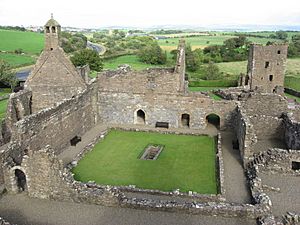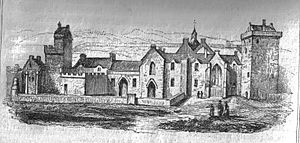Crossraguel Abbey facts for kids
 |
|
| Monastery information | |
|---|---|
| Order | Cluniac |
| Established | 1260s |
| Disestablished | 1617 |
| Mother house | Paisley Abbey |
| Diocese | Diocese of Glasgow |
| Controlled churches | Dailly; Girvan; Inchmarnock; Kirkudbright-Innertig; Kirkoswald; Straiton |
| People | |
| Founder(s) | Donnchadh, Earl of Carrick |
The Abbey of Saint Mary of Crossraguel is a fascinating ruin located near Maybole, South Ayrshire, Scotland. Even though it's mostly ruins, visitors can still explore the old church where monks worshipped. You can also see their cloister, which was a peaceful garden area, and their dovecot, a tower for pigeons.
Contents
Starting the Abbey: Crossraguel's Beginnings
Crossraguel Abbey was first planned in 1244 by Donnchadh, Earl of Carrick. He wanted to build a monastery and gave money and land to the monks of Paisley Abbey for this purpose. However, the Paisley monks only built a small chapel and kept most of the money for themselves.
The Earl was not happy about this. He took his complaint to the Bishop of Glasgow. The Bishop agreed with the Earl. He ordered the Paisley monks to build a proper abbey at Crossraguel. He also said some monks from Paisley should move there. These new monks at Crossraguel were allowed to choose their own leader, called an abbot.
What's in a Name? The Meaning of Crossraguel
The name Crossraguel comes from an old "Cross of Riaghail." This cross, named after St Regulus, once stood on the very spot where the abbey was built.
Crossraguel was a Cluniac abbey. The monks who lived there were part of a larger group called the Benedictines. They were often called the "Black monks" because of the dark robes they wore.
Crossraguel Abbey: A Look at Its History
The abbey faced a tough time in 1307 when an army led by Edward I of England attacked it. But the monks rebuilt Crossraguel, making it even bigger than before. It continued as a monastery until 1560. This was when the Scottish Reformation changed how religion was practiced in Scotland. Many monasteries closed down.
However, the few monks still living at Crossraguel were allowed to stay. They lived there until the last monk passed away in 1601. Some of the abbey's stones were later used to build other local structures. Despite this, Crossraguel remains one of the most complete medieval abbey ruins in Scotland.
Abbey's Role in Travel and Trade
Like Paisley Abbey, Crossraguel was part of the Cluny order. This order encouraged people to go on pilgrimages, which are journeys to holy places. It's no surprise that Crossraguel is located halfway between Paisley and Whithorn. This made it a perfect stop for pilgrims traveling to the shrine of St Ninian.
Around 1510, the monks at Crossraguel started new projects. With support from James IV, King of Scots, they began making salt by boiling seawater. They also ground charcoal, which was used to make gunpowder.
Changes and Challenges for the Abbey
In 1570, the powerful Kennedy family, who were Earls of Cassillis, took control of the lands belonging to Crossraguel Abbey. This happened in a controversial way involving Gilbert Kennedy, 4th Earl of Cassilis and Allan Stewart, the abbey's leader. This event led to a long-lasting feud between several families that continued until at least 1611.
The Reformation in the 1560s caused many abbeys to be destroyed. Crossraguel was not badly damaged, but monastic life there ended before the 16th century was over.
Visiting Crossraguel Today
Today, Crossraguel Abbey is a scheduled monument looked after by Historic Environment Scotland. It is open to the public, and you can visit to explore its ancient stones.
Even as a ruin, the abbey still shows many original parts. You can see the monks' church, their peaceful cloister, and the dovecot. There are also beautiful architectural details from the 15th century. The chapter house, where the monks met, is still standing. It even has benches for the monks and a special arched seat for the abbot. Visitors can also walk through the 15th-century choir building, which has fancy carvings. You can even climb stairs to the top of the gatehouse!
See also
- Abbot of Crossraguel, for a list of the abbey's leaders
- Abbeys and priories in Scotland




